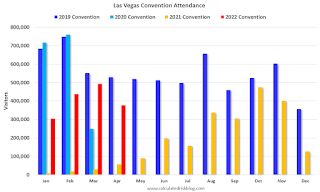by Calculated Risk on 6/01/2022 07:00:00 AM
Wednesday, June 01, 2022
MBA: Mortgage Applications Decrease in Latest Weekly Survey
From the MBA: Mortgage Applications Decrease in Latest MBA Weekly Survey
Mortgage applications decreased 2.3 percent from one week earlier, according to data from the Mortgage Bankers Association’s (MBA) Weekly Mortgage Applications Survey for the week ending May 27, 2022.
... The Refinance Index decreased 5 percent from the previous week and was 75 percent lower than the same week one year ago. The seasonally adjusted Purchase Index decreased 1 percent from one week earlier. The unadjusted Purchase Index decreased 2 percent compared with the previous week and was 14 percent lower than the same week one year ago.
“Mortgage rates fell for the fourth time in five weeks, as concerns of weaker economic growth and the recent stock market sell-off drove Treasury yields lower. Mortgage applications decreased to its lowest level since December 2018, as the purchase market continues to struggle with supply and affordability challenges,” said Joel Kan, MBA’s Associate Vice President of Economic and Industry Forecasting. “With the 30-year fixed rate at 5.33 percent, the refinance market continues to shrink, led by larger decreases last week for FHA and VA refinance applications. The refinance index was 75 percent below last year’s level, when rates were more than 200 basis points lower.”
Added Kan, “Purchase applications last week were 14 percent lower than last year, with more activity in the larger loan sizes. Demand is high at the upper end of the market, and supply and affordability challenges are not as detrimental to these borrowers as they are to first-time buyers.”
...
The average contract interest rate for 30-year fixed-rate mortgages with conforming loan balances ($647,200 or less) decreased to 5.33 percent from 5.46 percent, with points decreasing to 0.51 from 0.60 (including the origination fee) for 80 percent loan-to-value ratio (LTV) loans. The effective rate decreased from last week.
emphasis added
 Click on graph for larger image.
Click on graph for larger image.The first graph shows the refinance index since 1990.
 According to the MBA, purchase activity is down 14% year-over-year unadjusted.
According to the MBA, purchase activity is down 14% year-over-year unadjusted.Note: Red is a four-week average (blue is weekly).
Tuesday, May 31, 2022
Wednesday: Job Openings, ISM Mfg, Construction Spending, Beige Book, Vehicle Sales
by Calculated Risk on 5/31/2022 09:01:00 PM
From Matthew Graham at Mortgage News Daily: MBS Live Morning: Sharp Losses Reinforce Last Week's Yield Floor
10yr yields bounced at or near 2.72% for 4 straight days heading into the end of last week. Now this morning, they're sharply higher and already above the next major technical level at 2.83%. Even as bonds rallied in recent weeks, we've been expecting the gains to give way to a more volatile, sideways range. [30 year fixed 5.25%]Wednesday:
emphasis added
• At 7:00 AM ET: The Mortgage Bankers Association (MBA) will release the results for the mortgage purchase applications index.
• At 10:00 AM, Job Openings and Labor Turnover Survey for April from the BLS.
• Also at 10:00 AM, ISM Manufacturing Index for May. The consensus is for the ISM to be at 54.5, down from 55.4 in April.
• Also at 10:00 AM, Construction Spending for April. The consensus is for a 0.5% increase in construction spending.
• At 2:00 PM, the Federal Reserve Beige Book, an informal review by the Federal Reserve Banks of current economic conditions in their Districts.
• All day, Light vehicle sales for May. The consensus is for light vehicle sales to be 14.5 million SAAR in May, up from 14.3 million in April (Seasonally Adjusted Annual Rate). Wards Auto is forecasting a decline in sales to 13.4 million SAAR.
On COVID (focus on hospitalizations and deaths):
| COVID Metrics | ||||
|---|---|---|---|---|
| Now | Week Ago | Goal | ||
| Percent fully Vaccinated | 66.7% | --- | ≥70.0%1 | |
| Fully Vaccinated (millions) | 221.3 | --- | ≥2321 | |
| New Cases per Day3 | 94,260 | 104,396 | ≤5,0002 | |
| Hospitalized3 | 18,915 | 19,653 | ≤3,0002 | |
| Deaths per Day3🚩 | 301 | 288 | ≤502 | |
| 1 Minimum to achieve "herd immunity" (estimated between 70% and 85%). 2my goals to stop daily posts, 37-day average for Cases, Currently Hospitalized, and Deaths 🚩 Increasing 7-day average week-over-week for Cases, Hospitalized, and Deaths ✅ Goal met. | ||||
 Click on graph for larger image.
Click on graph for larger image.This graph shows the daily (columns) and 7-day average (line) of deaths reported.
Average daily deaths bottomed in July 2021 at 214 per day.
Fannie Mae: Mortgage Serious Delinquency Rate Decreased in April
by Calculated Risk on 5/31/2022 04:11:00 PM
Fannie Mae reported that the Single-Family Serious Delinquency decreased to 0.94% in April from 1.01% in March. The serious delinquency rate is down from 2.38% in April 2021. This is almost back to pre-pandemic levels.
These are mortgage loans that are "three monthly payments or more past due or in foreclosure".
The Fannie Mae serious delinquency rate peaked in February 2010 at 5.59% following the housing bubble and peaked at 3.32% in August 2020 during the pandemic.

By vintage, for loans made in 2004 or earlier (1% of portfolio), 2.98% are seriously delinquent (down from 3.12% in March).
Mortgages in forbearance are counted as delinquent in this monthly report, but they will not be reported to the credit bureaus.
The pandemic related increase in delinquencies was very different from the increase in delinquencies following the housing bubble. Lending standards had been fairly solid over the previous decade, and most of these homeowners had equity in their homes - and the vast majority of these homeowners have been able to restructure their loans once they were employed.
Freddie Mac reported earlier.
Update: Framing Lumber Prices Down 50% Year-over-year; Still up Sharply from Pre-pandemic Levels
by Calculated Risk on 5/31/2022 01:17:00 PM
Here is another monthly update on framing lumber prices.
This graph shows CME random length framing futures through May 31st.
Prices are still up sharply from the pre-pandemic levels of around $400.
 Click on graph for larger image.
Click on graph for larger image.The slowdown in housing - and some supply improvement - has pushed down prices.
Comments on March Case-Shiller and FHFA House Price Increases; New Record Monthly Increase
by Calculated Risk on 5/31/2022 09:40:00 AM
Today, in the Calculated Risk Real Estate Newsletter: Case-Shiller National Index up 20.6% Year-over-year in March; New Record Monthly Increase
Excerpt:
This graph below shows existing home months-of-supply (inverted, from the NAR) vs. the seasonally adjusted month-to-month price change in the Case-Shiller National Index (both since January 1999 through March 2022).
Note that the months-of-supply is not seasonally adjusted.
There is a clear relationship, and this is no surprise (but interesting to graph). If months-of-supply is high, prices decline. If months-of-supply is very low (like now), prices rise quickly.
In March, the months-of-supply was at 1.9 months, and the Case-Shiller National Index (SA) increased 2.09% month-over-month. The black arrow points to the March 2022 dot. In the April existing home sales report, the NAR reported months-of-supply increased to 2.2 months.
This month was very likely the peak YoY growth rate - just above the peak last August. Since inventory is now increasing year-over-year (but still low), we should expect price increases to slow.
The normal level of inventory is probably in the 4 to 6 months range, and we will have to see a significant increase in inventory to sharply slow price increases, and that is why I’m focused on inventory!
Since Case-Shiller is a 3-month average, and this report was for March (includes January and February), this included price increases when mortgage rates were significantly lower than today. In January, the Freddie Mac PMMS averaged 3.4% for a 30-year mortgage, and 3.8% in February. Currently mortgage rates are around 5.25%.emphasis added
Case-Shiller: National House Price Index increased 20.6% year-over-year in March
by Calculated Risk on 5/31/2022 09:11:00 AM
S&P/Case-Shiller released the monthly Home Price Indices for March ("March" is a 3-month average of January, February and March prices).
This release includes prices for 20 individual cities, two composite indices (for 10 cities and 20 cities) and the monthly National index.
From S&P: S&P Corelogic Case-Shiller Index Reports Annual Home Price Gain Of 20.6% In March
The S&P CoreLogic Case-Shiller U.S. National Home Price NSA Index, covering all nine U.S. census divisions, reported a 20.6% annual gain in March, up from 20.0% in the previous month. The 10-City Composite annual increase came in at 19.5%, up from 18.7% in the previous month. The 20-City Composite posted a 21.2% year-over-year gain, up from 20.3% in the previous month.
Tampa, Phoenix, and Miami reported the highest year-over-year gains among the 20 cities in March. Tampa led the way with a 34.8% year-over-year price increase, followed by Phoenix with a 32.4% increase, and Miami with a 32.0% increase. Seventeen of the 20 cities reported higher price increases in the year ending March 2022 versus the year ending February 2022.
...
Before seasonal adjustment, the U.S. National Index posted a 2.6% month-over-month increase in March, while the 10-City and 20-City Composites posted increases of 2.8% and 3.1%, respectively
After seasonal adjustment, the U.S. National Index posted a month-over-month increase of 2.1%, and the 10-City and 20-City Composites posted increases of 2.2% and 2.4%, respectively.
In March, all 20 cities reported increases before and after seasonal adjustments.
“Those of us who have been anticipating a deceleration in the growth rate of U.S. home prices will have to wait at least a month longer,” says Craig J. Lazzara, Managing Director at S&P DJI. “The National Composite Index recorded a gain of 20.6% for the 12 months ended March 2022; the 10- and 20-City Composites rose 19.5% and 21.2%, respectively. For both National and 20-City Composites, March’s reading was the highest year-over-year price change in more than 35 years of data, with the 10-City growth rate at the 99th percentile of its own history.
“The strength of the Composite indices suggests very broad strength in the housing market, which we continue to observe. All 20 cities saw double-digit price increases for the 12 months ended in March, and price growth in 17 cities accelerated relative to February’s report. March’s price increase ranked in the top quintile of historical experience for every city, and in the top decile for 19 of them.
emphasis added
 Click on graph for larger image.
Click on graph for larger image. The first graph shows the nominal seasonally adjusted Composite 10, Composite 20 and National indices (the Composite 20 was started in January 2000).
The Composite 10 index is up 2.2% in March (SA).
The Composite 20 index is up 2.4% (SA) in March.
The National index is 60% above the bubble peak (SA), and up 2.1% (SA) in March. The National index is up 117% from the post-bubble low set in February 2012 (SA).
 The second graph shows the year-over-year change in all three indices.
The second graph shows the year-over-year change in all three indices.The Composite 10 SA is up 19.5% year-over-year. The Composite 20 SA is up 21.2% year-over-year.
The National index SA is up 20.6% year-over-year.
Price increases were above expectations. I'll have more later.
Monday, May 30, 2022
Tuesday: Case-Shiller House Prices, Chicago PMI, Dallas Fed Mfg
by Calculated Risk on 5/30/2022 09:03:00 PM
Weekend:
• Schedule for Week of May 29, 2022
Tuesday:
• At 9:00 AM ET, S&P/Case-Shiller House Price Index for March. The consensus is for a 20.0% year-over-year increase in the Comp 20 index for March.
• Also at 9:00 AM, FHFA House Price Index for March 2022. This was originally a GSE only repeat sales, however there is also an expanded index.
• At 9:45 AM, Chicago Purchasing Managers Index for May.
• At 10:00 AM, Dallas Fed Survey of Manufacturing Activity for May.
From CNBC: Pre-Market Data and Bloomberg futures S&P 500 are up 9 and DOW futures are up 12 (fair value).
Oil prices were up over the last week with WTI futures at $116.53 per barrel and Brent at $121.15 per barrel. A year ago, WTI was at $66 and Brent was at $69 - so WTI oil prices are up 75% year-over-year.
Here is a graph from Gasbuddy.com for nationwide gasoline prices. Nationally prices are at $4.59 per gallon. A year ago prices were at $3.04 per gallon, so gasoline prices are up $1.55 per gallon year-over-year.
Lawler: Large Builders Acquired Lots of Lots over the Last Year
by Calculated Risk on 5/30/2022 12:42:00 PM
Today, in the Calculated Risk Real Estate Newsletter: Lawler: Large Builders Acquired Lots of Lots over the Last Year
A brief excerpt:
Over the last year some of the nation’s largest home builders acquired an enormous number of lots – either owned outright or “controlled” via land purchase option or other contracts – over the last year in anticipation of a continuation of a strong and perhaps even over-heated economy. Here are the number of lots owned or “controlled” for the three largest home builders.There is more in the article. You can subscribe at https://calculatedrisk.substack.com/
...Obviously, the land/lot acquisition strategy of these (and other) builders over the last 15 months reflected an assumption that the exceptionally strong (frothy?) housing market over that period would continue throughout this year. If, in fact, housing demand slows considerably this year, then there could be some serious weakness in the land/lot markets.
Housing Inventory May 30th Update: Inventory UP 5.7% Week-over-week
by Calculated Risk on 5/30/2022 10:06:00 AM
Altos reports inventory is up 11.4% year-over-year.
Inventory usually declines in the winter, and then increases in the spring. Inventory bottomed seasonally at the beginning of March 2022 and is now up 51% since then.
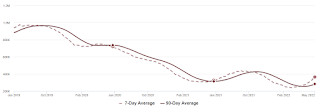
This inventory graph is courtesy of Altos Research.
Inventory is still very low. Compared to the same week in 2021, inventory is up 11.4% from 327 thousand, however compared to the same week in 2020 inventory is down 49.4% from 719 thousand. Compared to 3 years ago, inventory is down 61.6% from 948 thousand.
1. The seasonal bottom (happened on March 4th for Altos) ✅
2. Inventory up year-over-year (happened on May 13th for Altos) ✅
3. Inventory up compared to two years ago (currently down 49.4% according to Altos)
4. Inventory up compared to 2019 (currently down 61.6%).
Four High Frequency Indicators for the Economy
by Calculated Risk on 5/30/2022 08:40:00 AM
These indicators are mostly for travel and entertainment. It is interesting to watch these sectors recover as the pandemic subsides. Note: Apple has discontinued "Apple mobility", and restaurant traffic is mostly back to normal.
The TSA is providing daily travel numbers.
This data is as of May 29th.
 Click on graph for larger image.
Click on graph for larger image.This data shows the 7-day average of daily total traveler throughput from the TSA for 2019 (Light Blue), 2020 (Black), 2021 (Blue) and 2022 (Red).
The dashed line is the percent of 2019 for the seven-day average.
The 7-day average is down 9.5% from the same day in 2019 90.5% of 2019). (Dashed line)
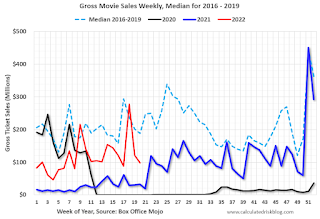 This data shows domestic box office for each week and the median for the years 2016 through 2019 (dashed light blue).
This data shows domestic box office for each week and the median for the years 2016 through 2019 (dashed light blue). Note that the data is usually noisy week-to-week and depends on when blockbusters are released.
Movie ticket sales were at $98 million last week, down about 48% from the median for the week.
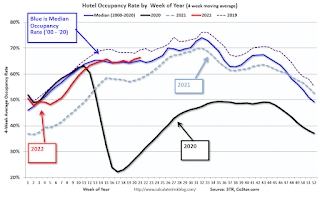 This graph shows the seasonal pattern for the hotel occupancy rate using the four-week average.
This graph shows the seasonal pattern for the hotel occupancy rate using the four-week average. The red line is for 2022, black is 2020, blue is the median, and dashed light blue is for 2021. Dashed purple is 2019 (STR is comparing to a strong year for hotels).
This data is through May 21st. The occupancy rate was down 3.5% compared to the same week in 2019.
Notes: Y-axis doesn't start at zero to better show the seasonal change.
Here is some interesting data on New York subway usage (HT BR).
 This graph is from Todd W Schneider.
This graph is from Todd W Schneider. This data is through Friday, May 27th.
He notes: "Data updates weekly from the MTA’s public turnstile data, usually on Saturday mornings".
Sunday, May 29, 2022
Energy expenditures as a percentage of PCE
by Calculated Risk on 5/29/2022 02:14:00 PM
During the early stages of the pandemic, energy expenditures as a percentage of PCE hit an all-time low of 3.3% of PCE. Then energy expenditures increased to 2018 levels by the end of last year.
This graph shows expenditures on energy goods and services as a percent of total personal consumption expenditures. This is one of the measures that Professor Hamilton at Econbrowser looks at to evaluate any drag on GDP from energy prices.

Click on graph for larger image.
Data source: BEA.
In general, energy expenditures as a percent of PCE has been trending down for decades. The huge spikes in energy prices during the oil crisis of 1973 and 1979 are obvious. As is the increase in energy prices during the 2001 through 2008 period.
Saturday, May 28, 2022
Real Estate Newsletter Articles this Week
by Calculated Risk on 5/28/2022 02:11:00 PM
At the Calculated Risk Real Estate Newsletter this week:
• The Household Mystery: Part II
• April New Home Sales Decline Sharply, almost 6 Months of Inventory Under Construction
• Final Look at Local Housing Markets in April
• Update: Delinquencies, Foreclosures and REO
• Realtor.com Reports Weekly Inventory Up 9% Year-over-year
This is usually published 4 to 6 times a week and provides more in-depth analysis of the housing market.
You can subscribe at https://calculatedrisk.substack.com/
Schedule for Week of May 29, 2022
by Calculated Risk on 5/28/2022 08:11:00 AM
The key report scheduled for this week is the May employment report.
Other key reports include the March Case-Shiller house prices, May ISM Manufacturing and Service surveys, and May Vehicle Sales.
All US markets will be closed in observance of Memorial Day.
 9:00 AM: S&P/Case-Shiller House Price Index for March.
9:00 AM: S&P/Case-Shiller House Price Index for March.This graph shows the year-over-year change in the seasonally adjusted National Index, Composite 10 and Composite 20 indexes through the most recent report (the Composite 20 was started in January 2000).
The consensus is for a 20.0% year-over-year increase in the Comp 20 index for March.
9:00 AM: FHFA House Price Index for March 2022. This was originally a GSE only repeat sales, however there is also an expanded index.
9:45 AM: Chicago Purchasing Managers Index for May.
10:00 AM: Dallas Fed Survey of Manufacturing Activity for May.
7:00 AM ET: The Mortgage Bankers Association (MBA) will release the results for the mortgage purchase applications index.
 10:00 AM ET: Job Openings and Labor Turnover Survey for April from the BLS.
10:00 AM ET: Job Openings and Labor Turnover Survey for April from the BLS. This graph shows job openings (yellow line), hires (purple), Layoff, Discharges and other (red column), and Quits (light blue column) from the JOLTS.
Jobs openings increased slightly in March to 11.549 million from 11.344 million in February. The number of job openings (yellow) were up 36% year-over-year.
10:00 AM: ISM Manufacturing Index for May. The consensus is for the ISM to be at 54.5, down from 55.4 in April.
10:00 AM: Construction Spending for April. The consensus is for a 0.5% increase in construction spending.
2:00 PM: the Federal Reserve Beige Book, an informal review by the Federal Reserve Banks of current economic conditions in their Districts.
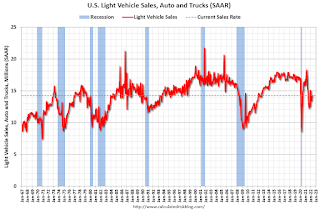 All day: Light vehicle sales for May. The consensus is for light vehicle sales to be 14.5 million SAAR in May, up from 14.3 million in April (Seasonally Adjusted Annual Rate).
All day: Light vehicle sales for May. The consensus is for light vehicle sales to be 14.5 million SAAR in May, up from 14.3 million in April (Seasonally Adjusted Annual Rate).This graph shows light vehicle sales since the BEA started keeping data in 1967. The dashed line is the sales rate for last month.
8:15 AM: The ADP Employment Report for May. This report is for private payrolls only (no government). The consensus is for 280,000 payroll jobs added in May, up from 247,000 in April.
8:30 AM: The initial weekly unemployment claims report will be released. The consensus is for 210 thousand unchanged from 210 thousand last week.
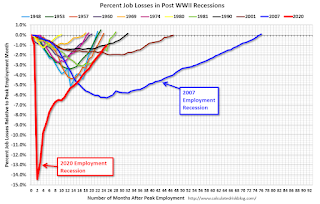 8:30 AM: Employment Report for May. The consensus is for 320,000 jobs added, and for the unemployment rate to decline to 3.5%.
8:30 AM: Employment Report for May. The consensus is for 320,000 jobs added, and for the unemployment rate to decline to 3.5%.There were 428,000 jobs added in April, and the unemployment rate was at 3.6%.
This graph shows the job losses from the start of the employment recession, in percentage terms.
The current employment recession was by far the worst recession since WWII in percentage terms. However, the current employment recession, 25 months after the onset, has recovered quicker than the previous two recessions.
10:00 AM: the ISM Services Index for May. The consensus is for a reading of 56.4, down from 57.1.
Friday, May 27, 2022
Q2 GDP Forecasts: Around 3.0%
by Calculated Risk on 5/27/2022 04:35:00 PM
From BofA:
We are tracking 3.0% qoq saar for 2Q GDP. Next week's trade data will be a big swing factor. [May 27 estimate]From Goldman:
emphasis added
The normalization in the trade balance was even larger than our previous assumptions, and we boosted our Q2 GDP tracking estimate by two tenths to +2.8% (qoq ar). [May 27 estimate]And from the Altanta Fed: GDPNow
The GDPNow model estimate for real GDP growth (seasonally adjusted annual rate) in the second quarter of 2022 is 1.9 percent on May 27, up from 1.8 percent on May 25. After this morning's releases from the US Bureau of Economic Analysis and the US Census Bureau, an increase in the nowcast of second-quarter real net exports was partially offset by a decrease in the nowcast of second-quarter real gross private domestic investment. [May 27 estimate]
Freddie Mac: Mortgage Serious Delinquency Rate decreased in April
by Calculated Risk on 5/27/2022 03:33:00 PM
Freddie Mac reported that the Single-Family serious delinquency rate in April was 0.85%, down from 0.92% March. Freddie's rate is down year-over-year from 2.15% in April 2021.
Freddie's serious delinquency rate peaked in February 2010 at 4.20% following the housing bubble and peaked at 3.17% in August 2020 during the pandemic.
These are mortgage loans that are "three monthly payments or more past due or in foreclosure".
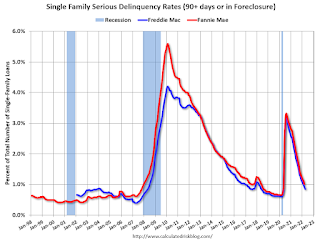
Mortgages in forbearance are being counted as delinquent in this monthly report but are not reported to the credit bureaus.
This is very different from the increase in delinquencies following the housing bubble. Lending standards have been fairly solid over the last decade, and most of these homeowners have equity in their homes - and they will be able to restructure their loans once (if) they are employed.
Las Vegas April 2022: Visitor Traffic Down 4.5% Compared to 2019
by Calculated Risk on 5/27/2022 12:34:00 PM
Note: I like using Las Vegas as a measure of recovery for both leisure (visitors) and business (conventions).
From the Las Vegas Visitor Authority: April 2022 Las Vegas Visitor Statistics
The pandemic recovery continued in April with strengthening visitation as the destination hosted nearly 3.4M visitors, roughly 31% ahead of last April and less than 5% behind April 2019.
Overall hotel occupancy reached 84%, up approx. 18.4 pts YoY and down only 7 pts vs. April 2019. Weekend occupancy exceeded 93% (up 9.7 pts YoY and down 3.5 pts vs. April 2019) and Midweek occupancy exceeded 79% (up 21.5 pts YoY and down 9.5 pts vs. April 2019).
Breaking the previous monthly record set just this past October, ADR exceeded $177, 62% ahead of last April and nearly 36% above pre‐COVID levels of April 2019 while RevPAR approached $149 for the month, dramatically ahead of April 2021 (+107.4%) and 25.4% over April 2019.
 Click on graph for larger image.
Click on graph for larger image. The first graph shows visitor traffic for 2019 (dark blue), 2020 (light blue), 2021 (yellow) and 2022 (red)
Visitor traffic was down 4.5% compared to the same month in 2019.
Note: There was almost no convention traffic from April 2020 through May 2021.
Update: Delinquencies, Foreclosures and REO
by Calculated Risk on 5/27/2022 10:22:00 AM
Today, in the Calculated Risk Real Estate Newsletter: Update: Delinquencies, Foreclosures and REO
A brief excerpt:
Last year, I pointed out that the foreclosure moratorium, combined with the expiration of a large number of forbearance plans, would NOT lead to a surge in foreclosures and impact house prices (as happened following the housing bubble).There is much more in the article. You can subscribe at https://calculatedrisk.substack.com/
...
Here is some data on REOs through Q1 2022 …
...
We will probably see an increase in REOs in 2022.
This graph shows the nominal dollar value of Residential REO for FDIC insured institutions. Note: The FDIC reports the dollar value and not the total number of REOs.
The dollar value of 1-4 family residential Real Estate Owned (REOs, foreclosure houses) increased slightly from $779 million in Q4 2021 to $788 million in Q1 2022. (Probably declined in 2020 and 2021 due to foreclosure moratoriums, forbearance programs and house price increases).
...
The bottom line is there will be an increase in foreclosures this year (from record low levels), but it will not be a huge wave of foreclosures as happened following the housing bubble. The distressed sales during the housing bust led to cascading price declines, and that will not happen this time.
Personal Income increased 0.4% in April; Spending increased 0.9%
by Calculated Risk on 5/27/2022 08:38:00 AM
The BEA released the Personal Income and Outlays report for April:
Personal income increased $89.3 billion (0.4 percent) in April, according to estimates released today by the Bureau of Economic Analysis. Disposable personal income (DPI) increased $48.3 billion (0.3 percent) and personal consumption expenditures (PCE) increased $152.3 billion (0.9 percent).The April PCE price index increased 6.3 percent year-over-year (YoY), down from 6.6 percent YoY in March.
Real DPI increased less than 0.1 percent in April and Real PCE increased 0.7 percent; goods increased 1.0 percent and services increased 0.5 percent. The PCE price index increased 0.2 percent. Excluding food and energy, the PCE price index increased 0.3 percent (
emphasis added
The following graph shows real Personal Consumption Expenditures (PCE) through April 2022 (2012 dollars). Note that the y-axis doesn't start at zero to better show the change.
 Click on graph for larger image.
Click on graph for larger image.The dashed red lines are the quarterly levels for real PCE.
Personal income was below expectations, and the increase in PCE was above expectations.
Thursday, May 26, 2022
Friday: Personal Income & Outlays
by Calculated Risk on 5/26/2022 09:01:00 PM
Friday:
• At 8:30 AM ET: Personal Income and Outlays, April 2021. The consensus is for a 0.6% increase in personal income, and for a 0.7% increase in personal spending. And for the Core PCE price index to increase 0.3%. PCE prices are expected to be up 6.3% YoY, and core PCE prices up 4.9% YoY.
• At 10:00 AM: University of Michigan's Consumer sentiment index (Final for May). The consensus is for a reading of 59.1.
On COVID (focus on hospitalizations and deaths):
| COVID Metrics | ||||
|---|---|---|---|---|
| Now | Week Ago | Goal | ||
| Percent fully Vaccinated | 66.6% | --- | ≥70.0%1 | |
| Fully Vaccinated (millions) | 221.1 | --- | ≥2321 | |
| New Cases per Day3🚩 | 109,564 | 101,091 | ≤5,0002 | |
| Hospitalized3🚩 | 19,949 | 17,491 | ≤3,0002 | |
| Deaths per Day3🚩 | 305 | 278 | ≤502 | |
| 1 Minimum to achieve "herd immunity" (estimated between 70% and 85%). 2my goals to stop daily posts, 37-day average for Cases, Currently Hospitalized, and Deaths 🚩 Increasing 7-day average week-over-week for Cases, Hospitalized, and Deaths ✅ Goal met. | ||||
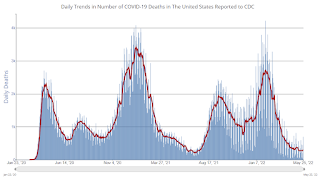 Click on graph for larger image.
Click on graph for larger image.This graph shows the daily (columns) and 7-day average (line) of deaths reported.
Average daily deaths bottomed in July 2021 at 214 per day.
Hotels: Occupancy Rate Down 3.5% Compared to Same Week in 2019
by Calculated Risk on 5/26/2022 04:11:00 PM
U.S. hotel performance increased from the previous week, according to STR‘s latest data through May 21.The following graph shows the seasonal pattern for the hotel occupancy rate using the four-week average.
May 15-21, 2022 (percentage change from comparable week in 2019*):
• Occupancy: 68.6% (-3.5%)
• Average daily rate (ADR): $151.75 (+13.4%)
• Revenue per available room (RevPAR): $104.06 (+9.5%)
*Due to the pandemic impact, STR is measuring recovery against comparable time periods from 2019.
emphasis added
 Click on graph for larger image.
Click on graph for larger image.The red line is for 2022, black is 2020, blue is the median, and dashed light blue is for 2021. Dashed purple is 2019 (STR is comparing to a strong year for hotels).


